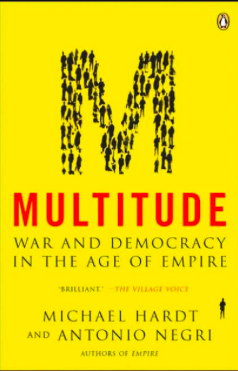Michael Hardt and Antonio Negri’s Multitude. War and Democracy in The Age of Empire (2004) is the volume that follows Empire (2000). While the first volume offered a description of the reactive regime that followed the years after the end of the Cold War, that is, the formation of Empire, the second volume offers the project of the multitude, the active agent of change, that which precedes and presupposes Empire. If empire works by a flexible regime that expands like a network, but also that eludes easy clear-cut definitions, the multitude is the active collective subject that can dismantle Empire. The biggest challenge is, then, face “the global state of war” (xi) that beats at the heart of Empire. In a way, the book was thought to reflect on events that reply shook the world during the first years of the millennium. While, perhaps, somethings depicted by the book did not aged well —like the prediction that algorithm knowledge production would enable new forms of collective identities or freedoms— some of the main ideas of Multitude are still relevant and important.
The book’s main project is to describe the “multitude.” This concept was, in a way described in the previous book. But what makes different Multitude from Empire is that the first will focus exclusively on the challenges that the concept of multitude faces today, from both right and left, from war and democracy. This collective subject, early in the book, is defined as an “open and expansive network in which all differences can be expressed freely and equally, a network that provides the means of encounter so that we can work and live in common” (xiv). What this concept offers, then, is openness and expansiveness as means to counter the closure and exclusion present in a world divided in an undividable war of all against all. That is, the multitude is the virtual promise for a world that is in stasis, in a civil war, in perpetual terror. It is not that difference is erased under the multitude, but what is at stake is the possibility of imagining a collectivity that does not serve identitarian means (like the political subject of the “people”) or like the unified collective subject of the “masses,” widely used and abused by work unions and so on.
In a way, the book offers a radical way out from the politics of the twentieth century. The multitude truly is the way out of the politics of the party, of hegemony (even if the book does not mention this). But, at the same time the book does not go far enough. By focusing exclusively on democracy, as the only mean through which the multitude can expand its project, the book seems limit its own powerful concept. In fact, democracy is also tied to its own diseases, like representation. If as we are told, repeatedly, after the second half of the book, that representation is a mechanism that connects and separates (242-244), then, to what extent does the multitude needs representation? Or to put it differently, why does the politics of desire and positive affects of the multitude still needs a mechanism that, itself, is a trap? To a certain extent, this would imply that politics is unescapable from representation, but to another extent, the book could also suggest that the multitude errs. That is, since the multitude is “a diffuse set of singularities that produce a common life; it is a kind of social flesh that organizes itself into a new social body” (349), and consequently, representation is just one of the toys of the playful and creative forms of politics that the multitude is capable of creating. Then, as any other toy, representation will be no longer fun, but only time and the multitude would tell.



